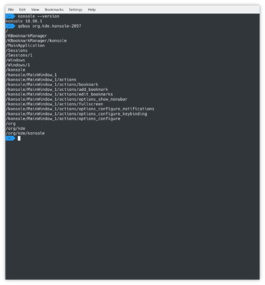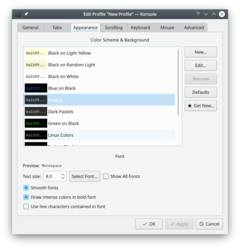Konsole
Template:I18n/Language Navigation Bar
 |
Konsole è l'emulatore di terminale per la piattaforma KDE |
Panoramica delle caratteristiche
- Emulatore di terminale X
- Facilita l'uso della linea di comando
- Consente di utilizzare profili diversi per compiti diversi
- Consente di impostare limiti di scorrimento delle linee e salvare il contenuto su file
- Facendo clic sui link questi vengono aperti nel browser web predefinito dell'utente
- Apertura del percorso corrente nel gestore di file predefinito
- Sfondo semitrasparente disponibile quando gli effetti desktop sono abilitati
Konsole è un emulatore di terminale X per la piattaforma KDE che consente agli utenti di avere una modalità comoda per usare la riga di comando. Oltre a fornire un modo per utilizzare una potente shell, Konsole offre anche caratteristiche che rendono più facile o più piacevole lavorare con la linea di comando, come la gestione dei profili, lo scorrimento e gli schemi di colore, inclusa la semitrasparenza.
Konsole fornisce inoltre un terminale integrabile KPart che è utilizzato da applicazioni come Yakuake, Dolphin e Kate, offrendo agli utenti un'interfaccia coerente e familiare quando si lavora nella riga di comando.
Guide e suggerimenti
Language
With Konsole You can change the language to plain English (to see bugs info for example) by command:
export LANG=C
Shortcuts
- Switch tab: SHIFT+LEFT, SHIFT+RIGHT (not like X-Chat, Firefox, Quanta, Kdevelop). Note that Quanta and Kdevelop use ALT+LEFT, ALT+RIGHT. However, SHIFT+DIRECTION has the advantage of being reachable with one hand on virtually all keyboard layouts, while ALT keys are sometimes only on the left of the keyboard (e.g. in Germany).
- New tab: SHIFT+CRTL+N.
Label your Tabs
If you regularly use a lot of tabs, you'll sometimes find it convenient to label them. Just double-click on the tab and you'll get a re-name dialogue.
Profile Management
- To add a new profile go to
- On the tab, enter the new profile name and change the icon if desired.
- If this is to be a root konsole, enter the command
/bin/su -
This command will not work on any distro that uses sudo (like Ubuntu). On such distributions use:
sudo su
or just prepend all your commands that requires superuser priviledges with sudo.
- Font size can also be changed on the tab.

- On the screen you can add or remove a star, which controls whether that profile is to be offered on the File menu.
Related Sites
Keywords
Terminal emulator, command line, CLI, shell
